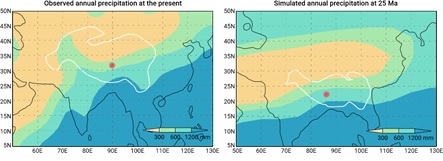As an important part of global atmospheric circulation, the Asian monsoon greatly affects the ecological system and social economy in Asia.
Currently, an increasing number of researchers are involved in identifying the conditions that led to the initial onset and development of the Asian monsoon. However, the evolution and related driving forces of the Asian monsoon before Miocene are still controversial.
A collaborative team led by Prof. WANG Yu-Fei from the Institute of Botany, Chinese Academy of Sciences (IBCAS), Prof. DENG Tao from the Institute of Vertebrate Paleontology and Paleoanthropology, Chinese Academy of Sciences (IVPPCAS) and Prof. LIU Xiao-Dong Institute of Earth Environment, Chinese Academy of Sciences (IEECAS) firstly reconstructed the precipitation data of central Tibet during ca. 26-16 Ma by applying the coexistence approach to sedimentary pollen data, and thus detected an intensified Asian monsoon during this time by utilizing the definition of the modern monsoon into paleomonsoon study.
Researchers use paleoclimate modeling to show that the study area in central Tibet was located at ~22.27 °N at 25 Ma, where the climate was controlled by the intertropical convergence zone (ITCZ) in summer but not in winter. Similar to the generation mechanism of modern tropical monsoon, a monsoon climate likely also has developed in central Tibet during the Late Oligocene to Early Miocene under the influence of the ITCZ.
Through spectral analysis at the 95% confidence level with a Monte Carlo test, researchers revealed that the Asian monsoon fluctuated in ~1.35 Ma and ~0.33 Ma cycles, which appears to correspond to the eccentricity with a ~0.4 Ma cycle and the obliquity amplitude with a ~1.2 Ma cycle during ca. 26-16 Ma. This coupling relationship suggest that the fluctuations in the Asian monsoon during 26-16 Ma can be attributed to the long-period cyclicities in obliquity (~1.2 Ma).
These findings provide climate data that can be used to understand the Asian monsoon evolution during the Late Oligocene to Early Miocene and highlight the effects of paleogeographic patterns and long-period orbital forcings on the tectonic-scale evolution of the Asian monsoon.
The study has been published in The Innovation.

Paleogeographic changes is responsible for the survival of the Asian monsoon in the central Tibetan Plateau during the Late Oligocene to Early Miocene. (by IBCAS)
Article Link: https://doi.org/10.1016/j.xinn.2021.100110
Contact: WANG Yufei
Email:wangyf@ibcas.ac.cn
Institute of Botany, Chinese Academy of Sciences
As an important part of global atmospheric circulation, the Asian monsoon greatly affects the ecological system and social economy in Asia.
Currently, an increasing number of researchers are involved in identifying the conditions that led to the initial onset and development of the Asian monsoon. However, the evolution and related driving forces of the Asian monsoon before Miocene are still controversial.
A collaborative team led by Prof. WANG Yu-Fei from the Institute of Botany, Chinese Academy of Sciences (IBCAS), Prof. DENG Tao from the Institute of Vertebrate Paleontology and Paleoanthropology, Chinese Academy of Sciences (IVPPCAS) and Prof. LIU Xiao-Dong Institute of Earth Environment, Chinese Academy of Sciences (IEECAS) firstly reconstructed the precipitation data of central Tibet during ca. 26-16 Ma by applying the coexistence approach to sedimentary pollen data, and thus detected an intensified Asian monsoon during this time by utilizing the definition of the modern monsoon into paleomonsoon study.
Researchers use paleoclimate modeling to show that the study area in central Tibet was located at ~22.27 °N at 25 Ma, where the climate was controlled by the intertropical convergence zone (ITCZ) in summer but not in winter. Similar to the generation mechanism of modern tropical monsoon, a monsoon climate likely also has developed in central Tibet during the Late Oligocene to Early Miocene under the influence of the ITCZ.
Through spectral analysis at the 95% confidence level with a Monte Carlo test, researchers revealed that the Asian monsoon fluctuated in ~1.35 Ma and ~0.33 Ma cycles, which appears to correspond to the eccentricity with a ~0.4 Ma cycle and the obliquity amplitude with a ~1.2 Ma cycle during ca. 26-16 Ma. This coupling relationship suggest that the fluctuations in the Asian monsoon during 26-16 Ma can be attributed to the long-period cyclicities in obliquity (~1.2 Ma).
These findings provide climate data that can be used to understand the Asian monsoon evolution during the Late Oligocene to Early Miocene and highlight the effects of paleogeographic patterns and long-period orbital forcings on the tectonic-scale evolution of the Asian monsoon.
The study has been published in The Innovation.

Paleogeographic changes is responsible for the survival of the Asian monsoon in the central Tibetan Plateau during the Late Oligocene to Early Miocene. (by IBCAS)
Article Link: https://doi.org/10.1016/j.xinn.2021.100110
Contact: WANG Yufei
Email:wangyf@ibcas.ac.cn
Institute of Botany, Chinese Academy of Sciences
